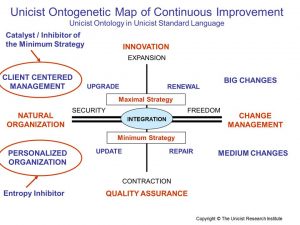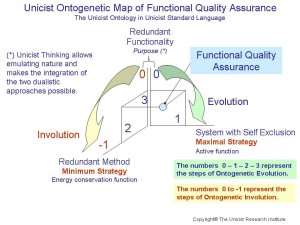The Power of Unicist Object Driven Continuous Improvement
The purpose of continuous improvement is to increase effectiveness.
 The active principle that sustains the maximal strategy is driven by innovation and the energy conservation principle that sustains the minimum strategy is based on quality assurance.
The active principle that sustains the maximal strategy is driven by innovation and the energy conservation principle that sustains the minimum strategy is based on quality assurance.
Unicist continuous improvement integrates innovation to improve the processes and objects that are being used to implement medium and /or big changes, using quality assurance, the client centered management model and the personalized organization model to ensure the achievement of a higher level of effectiveness.
Maximal strategies are driven by innovation. They are put into action by the implementation of big changes that go beyond the existing boundaries of the present operation and are sustained by the external need represented by the client centered management.
Minimum strategies are driven by quality assurance, put into action by the development and implementation of medium changes and sustained by the personalized organization that ensures an effective participative action model.
The operational aspects of this unicist continuous improvement process can be defined as:
1) Internal Project Managers
There have to be internal project managers who participate in a learning program to deal with a unicist strategic approach to change and continuous improvement.
2) Unicist Change Management Technology
The unicist change management technology has specific objects, procedures and methods to be used to manage change.
3) External Quality Assurance
Quality assurance is a core aspect that needs to be provided externally in order to avoid paradoxical results when introducing changes. The quality assurance process includes both object driven quality assurance and personal control of objects and processes.
4) Objects as drivers, entropy inhibitors and catalysts of change
The unicist approach is based on the use of objects to drive change, inhibit the loss of energy and catalyze the speed of the change. The shorter the transition is, the better the results.
5) Unicist Continuous Improvement Technology
The unicist continuous improvement technology described in the following synthesis allows the development of changes considering the introduction of “changes without changing” based on a participative way to introduce them changing results without changing the real nature of the object/process to be changed.
Conclusions
Big changes have to be considered as necessary changes in order to be communicated internally. They need to be managed integrating the technologies of analytical and fundamental analysis to define the problems.
They need to be sustained by continuous improvement actions and an object driven organization to ensure that the outcome of this change is an effective structured solution and not only a conjunctural subjective approach to solve an extreme need.
Diego Belohlavek
NOTE: The Unicist Research Institute was the pioneer in complexity science research and became a private global decentralized leading research organization in the field of human adaptive systems. http://www.unicist.org

